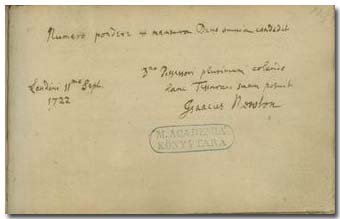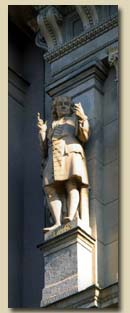
Numero pondere & mensura Deus omnia
condidit. *
D[omi]no Possessori plurimum colendo hanc
Tesseram suam posuit
Isaacus Newton
Londini 11mo Sept. 1722
|
|
God hath ordered all things in measure and number and weight. *
I recommend this motto of mine to the much
respected possessor [of this book].
Isaac Newton
In London, on September 11, 1722.
|
p.
109. London, September 22, 1722
 Newton, Isaac, Sir Newton, Isaac, Sir
(1643-1727), English physicist,
mathematician, astronomer
Isaac
Newton was born on January 4, 1643 in Woolsthorpe Manor near
Grantham in Lincolnshire. In England, where the Julian calendary
was still observed, this day fell on Christmas, December 25. His
father, Isaac Newton died at the age of 36, three months before
the birth of his son. His mother Hannah Smith married again and
moved to her husband's town. Isaac's grandmother stayed in
Woolsthorpe Manor, and took care of him. In 1655 he was sent to
the grammar school of Grantham, but after the death of his
stepfather his mother called him home to work in the manor.
However, his uncle and the rector of the school managed to
convince her to let him back to school. He lived at the town's
pharmacist, and already at this time he prepared curious
instruments, small mills and water-meters. In 1661 he went to Trinity
College in Cambridge, where he read mathematics and philosophy.
During the plague years of 1665-66 the college was closed, and
Newton went back to Woolsthorpe. Here he made his great
discoveries, the differential and integral calculus, the theory of
colours, the laws of dynamics, as well as the law of universal
gravitation, but at this time he did not publish either of them.
In 1667 he became fellow of the College, and in the following year
Master of Art. In this year he prepared his first mirror
telescope. In 1669 his professor Isaac Barrow (1630-1677), himself
one of the forerunners of differential calculus, resigned, and
gave his post to his brilliant student. Newton began his lectures
on optics in the Trinity College in 1670. In 1672 he was
elected a member of the Royal Society of London; he demonstratd
his telescope, and presented his first treatise on the theory of
light and colours. However, the disputes following thereafter,
principally the sharp criticism of Robert Hooke prevented him from
publishing his results. Hooke also accused him of having stolen
his recognitions on the interpretation of the movement of the
planets. Finally, through the reconciling intervention of Edmond
Halley, and with his financial support and stimulation in 1687 he
published one of his chief-d'oeuvres: Philosophiae naturalis principia mathematica,
treating the laws of dynamics and general gravitation. In this
topic he also had correspondence with Richard Bentley, the future
Master of Trinity College. In 1697 he was sorely tried by the
death of his mother. He also continued to support the family of
his half-brothers. In 1692 he fell in a deep exhaustion, and he
completely retired from scholarly work for two years. In 1689 and
in 1701-1702 he represented the University of Cambridge in the
Parliament of London. In 1696 he became Warden, and from 1699 the
Director of the British mint. He moved to London, and from 1703
until his death he was President of the Royal Society. In 1704
he published his second chef-d'oeuvre, the Optics, on the
nature of light. In 1705 he was knighted by Queen Anne for his
scholarly merits, as well as for his efforts done in the Mint.
His unfortunate dispute of precedence with Leibniz
had begun some years earlier, and it left him no peace neither
after the death of Leibniz: it embittered all his life, caused a
great harm to the development of mathematics, and especially in
British scholarly life. The German mathematician and philosopher Gottfried Wilhelm Leibniz (1646-1716)
discovered parallel with Newton the differential and integral
calculus, and he published his results in 1684 and 1686. Newton
had arrived to these same recognitions earlier, but he spread them
only in a narrow circle, and published them only in 1704, in two
articles connected with the Optics. The notation introduced
by Leibniz is simpler and more uniform. The merits of both are
indisputable. The basic theorem of mathematical analysis
expressing the connection between differential and integral
calculus is today called Newton-Leibniz-theorem.
Sir Isaac Newton
founded no family. He died on March 31, 1727 (according to the old
calendar, on March 20), and was buried in Westminster Abbey. His
long Latin epitaph gives an account of his scholarly merits [Jöcher III 891].
His two most important works are the Philosophiae
naturalis principia mathematica. London, 1687. Mathematical
Principles of Natural Philosophy. London, 1729. – Opticks,
or, a treatise of the reflexions, refractions, inflexions and
colours of light. Also two treatises of the species and magnitude
of curvilinear figures. London, 1704.
Newton was extremely respected and legends
circulated about him already in his life. Even in later times anecdotes were
made on his modesty and distractedness, that obfuscate reality to
some degree. The literature around his personality and scholarly
achievements amounts to a whole library. Even Voltaire belonged to
his popularizers. Today every schoolboy knows the name of Newton.
If one has a single look at a lexicon of natural sciences, or an
index of a handbook of mathematics or physics, will suddenly find
a handful of expressions or theorems beginning like
“Newton's…”: and continuing like binominal theorem, liquid,
ring, law of cooling, alloy, telescope… The unit of force
in the SI (Système Internationale) has borrowed his name: it is
called newton, and abbreviated as N. All the achievements of
Newton had their foundations in the thoughts of his forerunners,
Galilei, Kepler, Descartes and others, but he (and Leibniz in the
field of mathematics) organized these into unified theories. He
indicated new directions in scholarly and philosophical thought,
like that white light can be decomposed into colours, that force is
needed not to maintain movement, but to change it, that celestial and terrestrial phenomena (weight of
bodies, ebb and flow, the movement of the moon and of the planets)
obey the same laws, that one has to base his theories both on
experience and thought. The 17th century, “le grand siècle”, was
the century of genius. Newton himself wrote to Hooke in 1676: “If
I have been able to see further, it was only because I stood on
the shoulders of giants.” He was right, but only a Newton
was able to step on the shoulders of the giants. Trinity
College of Cambridge still keeps some of his personal objects and
manuscripts. His statue there bears the inscription from
Lucretius: Qui genus humanum ingenio superavit.
Isaac Newton choose a motto really fitting to
himself from the Bible, one written eighteen centuries earlier by
the Jewish philosopher of Alexandria: Thou [God] hast ordered
everything in measure and number and weight. – Edmond Halley has
noted in the Album of Páriz Pápai in 1716 in Oxford (p.
237).
•
BritHung • DNB • Filep • Jöcher • Jöcher-Adelung • MNL •
Newton-Fehér • Newton-Heinrich • Newton-web • Simonyi • Vekerdi |

